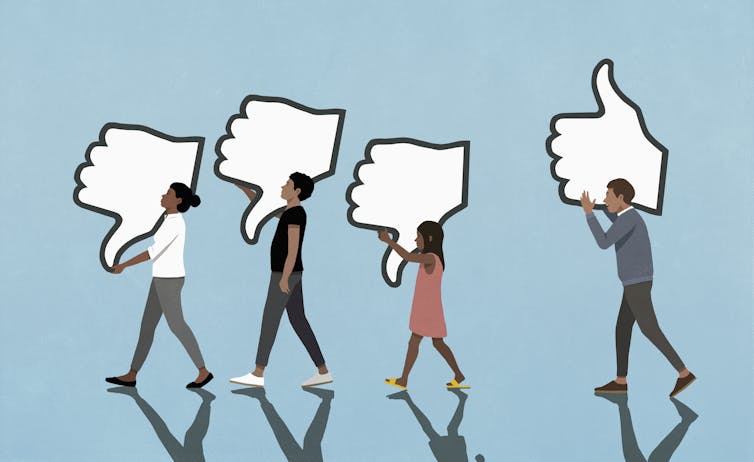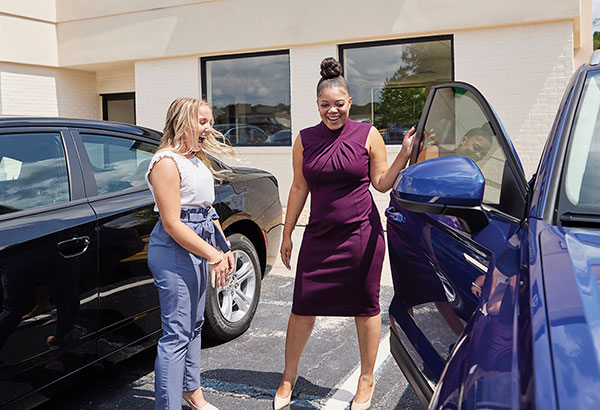
If you pay any attention to politics and polling, you have likely heard that your friends and neighbors are not very happy with the direction of the country. You might not be, either.
One ABC News/Ipsos survey in November 2023 showed three-quarters of Americans believed the country was on the “wrong track.” Only 23% believed it was headed in the “right direction.”
And the survey was not an outlier. Poll after poll shows a sizable majority of the nation’s residents disapprove of its course.
Have Americans – long seen as upbeat, can-do optimists – really grown dour about the state of the nation and where it’s headed?
The answer, we think, is yes and no. Or, to be more direct, as the researchers who run the American Communities Project, which explores the differences in 15 different types of community in the United States, we believe the surveys are asking a question with no real meaning in the United States in 2024 – a question that may have outlived its usefulness.
An ‘astonishing finding’
“Do you feel things in the country are generally going in the right direction, or do you feel things have gotten off on the wrong track?”
That question or one very much like it is well known to anyone who has glanced at a poll story or studied the data of a survey in the past 50 years.
These public opinion surveys, often sponsored by news organizations, seek to understand where the public stands on the key issues of the day. In essence, they tell the public about itself. Political parties and candidates often conduct their own surveys with a version of the “right direction/wrong track” question to better understand their constituencies and potential voters.
The American Communities Project, based at Michigan State University, uses demographic and socioeconomic measures to break the nation’s 3,100 counties into 15 different types of communities – everything from what we label as “big cities” to “aging farmlands.” In our work with the project, we’ve found a strong reason to be skeptical of the “right direction/wrong track” question. Simply put, the divisions in the country have rendered the question obsolete.
In 2023, we worked with Ipsos to survey more than 5,000 people across the country in all those community types. We asked the survey participants what issues they were concerned about locally and nationally. How did they feel about the Second Amendment? About gender identity? About institutional racism? We found a lot of disagreement on those and other controversial issues.
But there were also a few areas of agreement. One of the big ones: In every community we surveyed, at least 70% said the country was on the “wrong track.” And that is an astonishing finding.
Agreement for different reasons
Why was that response so surprising?
The community types we study are radically different from each other. Some are urban and some are rural. Some are full of people with bachelor’s degrees, while others have few. Racially and ethnically, some look like America as it is projected to be in 30 years – multicultural – and some look like the nation did 50 years ago, very white and non-Hispanic. Some of the communities voted for President Joe Biden by landslide numbers in 2020, while others did the same for Donald Trump.
Given those differences, how could they be in such a high level of agreement on the direction of the country?
To answer that question, we visited two counties in New York state in January that are 3½ hours and several worlds away from each other: New York County, which is labeled a “big city” in our typology and encompasses Manhattan, and Chenango County, labeled “rural middle America” in our work, located in the south-central part of the state.
In 2020, Biden won 86% of the vote in big metropolitan Manhattan, and Trump won 60% in aging, rural Chenango.
When we visited those two counties, we heard a lot of talk of America’s “wrong track” in both places from almost everyone. More important, we heard huge differences in “why” the country was on the wrong track.
“If something don’t change in the next election, we’re going to be done. We’re going to be a socialist country. They’re trying to tell you what you can do and can’t do. That’s dictatorship, isn’t it? Isn’t this a free country?” said James Stone, 75, in Chenango County.
Also in Chenango County, Leon Lamb, 69, is concerned about the next generation.
“I’m worried about them training the kids in school,” he said. “You got kids today who don’t even want to work. They get free handouts … I worked when I was a kid … I couldn’t wait to get out of the house. I wanted to be on my own.”
In New York City, meanwhile, Emily Boggs, 34, a theater artist, bartender and swim instructor, sees things differently as she struggles to make ends meet.
“We’ve been pitched since we were young, that like, America is the best country in the world. Everyone wants to be here, you’re free, and you can do whatever you want,” Boggs said. “And it’s like, well, if you have the money … I’ve got major issues with millionaires and billionaires not having to pay their full share of taxes, just billionaires existing … It’s the inequality.”
A lifelong New York City resident, Harvey Leibovitz, 89, told us: “The country is on the wrong direction completely. But it’s based upon a very extreme but significant minority that has no regard to democracy, and basically, in my opinion, is racist and worried about the color of the population.”
Opposite views in same answer
To be clear, we are not saying that asking people about the direction of the country is completely worthless. There may be some value in chronicling Americans’ unhappiness with the state of their country, but as a stand-alone question, “right direction/wrong track” is not very helpful. It’s the beginning of a conversation, not a meaningful measure.
One person’s idea about the country being on the wrong track may be completely the opposite of another person’s version of America’s wrong direction.
It’s easy to grasp the appeal of one broad question aimed at summarizing people’s thoughts. But in a complicated and deeply fragmented country, a more nuanced view of the public’s perceptions of the nation would help Americans understand more about themselves and their country.![]()
Dante Chinni, Director, American Communities Project, Michigan State University and Ari Pinkus, Manager, American Communities Project, Michigan State University
This article is republished from The Conversation under a Creative Commons license.




 Upgrade to an Energy-Efficient HVAC System. If your HVAC system is outdated, consider replacing it with a more energy-efficient model. Look for systems with an Energy Star or high SEER2 (seasonal energy efficiency ratio) rating, which indicates better energy efficiency. The higher the SEER2 rating, the more efficient the unit. Financial incentives for installing a higher-efficiency system are available through the
Upgrade to an Energy-Efficient HVAC System. If your HVAC system is outdated, consider replacing it with a more energy-efficient model. Look for systems with an Energy Star or high SEER2 (seasonal energy efficiency ratio) rating, which indicates better energy efficiency. The higher the SEER2 rating, the more efficient the unit. Financial incentives for installing a higher-efficiency system are available through the 


 Make your home environment print-rich, as the more exposure children have to letters and words, the better. For example, keep magnetic letters and words on the fridge, put labels on your toy containers and position books and magazines in different rooms. Also remember reading isn’t limited to books. Words are everywhere, from street signs to restaurant menus. Take advantage of every opportunity to connect with your children through words throughout your day.
Make your home environment print-rich, as the more exposure children have to letters and words, the better. For example, keep magnetic letters and words on the fridge, put labels on your toy containers and position books and magazines in different rooms. Also remember reading isn’t limited to books. Words are everywhere, from street signs to restaurant menus. Take advantage of every opportunity to connect with your children through words throughout your day.
 While commercial bird feeds aim to provide basic nutrition for birds, the quality and nutritional content can vary. Some mixes contain a high proportion of less desirable seeds and fillers, offering limited nutritional value.
While commercial bird feeds aim to provide basic nutrition for birds, the quality and nutritional content can vary. Some mixes contain a high proportion of less desirable seeds and fillers, offering limited nutritional value.
 Used car prices have been trending downward month-over-month, according to the Bureau of Labor Statistics’ consumer price index. These decreases in used car prices are helping offset higher than normal interest rates. The average sales price for a pre-owned vehicle through
Used car prices have been trending downward month-over-month, according to the Bureau of Labor Statistics’ consumer price index. These decreases in used car prices are helping offset higher than normal interest rates. The average sales price for a pre-owned vehicle through 








